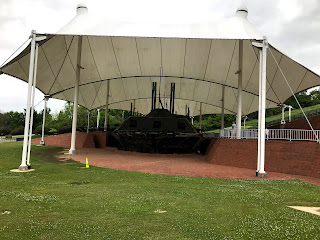On Tuesday, after giving Hanna a good long walk, I locked her in Minnie and took off toward Port Gibson. On the way south, I stopped at Magnum Mound, an old Indian ceremonial mound, and Sunken Trace. The sunken trace was quite impressive, where you can walk down and onto the actual path the traders walked, which was worn down by many footprints and natural elements. I only stayed about 15 minutes, but will go back before I leave the area.
I drove on to Port Gibson, which is a small town on the Mississippi River with great historical impact. During the Civil War, the Union took it from the Confederacy, but General U.S. Grant spared the town, declaring it “too beautiful to burn”. There are dozens of old beautiful churches lining the streets, each with its own story. I continued through the town and on to the Windsor Ruins. This beautiful southern plantation survived the Civil War, but was destroyed by fire in 1890. Only the stately columns remain.
From there, I drove north to Grand Gulf Military Monument. Another key strategic location along the Mississippi, General Grant fought several battles to finally take the stronghold in his quest to finally conquer Vicksburg. They have quite an extensive museum and grounds filled with memorabilia from the war, but unfortunately, I got the impression the artifacts were not well cared for. Everything on display had a thick layer of dust, and some of it is exposed to the elements and visitors' touch. But I wandered the grounds and picked up lots of new information about the war in that area.
From there, I drove back to my camp and a pup who was happy to see me.
On Wednesday, I decided to drive up to Vicksburg National Military Park. At the last minute, I downsized my purse contents to a fanny pack, and forgot to put my Senior Pass in. When I arrived at the park, I realized I would have to pay the $15 entrance fee for my mistake. It was worth it, though. I drove the Tour Road around the park, stopping along the way to read about massive battles and view monuments. Vicksburg was the key stronghold standing in the Union's way of complete control of the Mississippi River. Fighting for this city began in October 1862, but surrender of the city would not come until July 4, 1863. Tens of thousands of soldiers died during those nine months, and the National Cemetery on the park site is evidence of those losses. Headstones as far as the eye can see.
The other significant war relic displayed at the Park is the U.S.S. Cairo. This Civil War ironclad warship was sunk during the siege of 1863, where it rested for over 100 years before being recovered and reassembled and opened to public viewing at Vicksburg National Military Park.
I returned to my camp for a couple of days of rest.
I returned to my camp for a couple of days of rest.




















How nice that you got to see all this history. I have been to many Civil War sites in the Northeast and along the AT as I hiked. I would love to visit the Civil War battlefields and the early American trails of the deep South. Do they still have monuments of the Confederate Generals at the battlefields?
ReplyDeleteYes, many many monuments to Confederate officers remain in the parks. Surprisingly, I heard, most of the Confederate dead are buried in private or city cemeteries rather than National cemeteries.
Delete